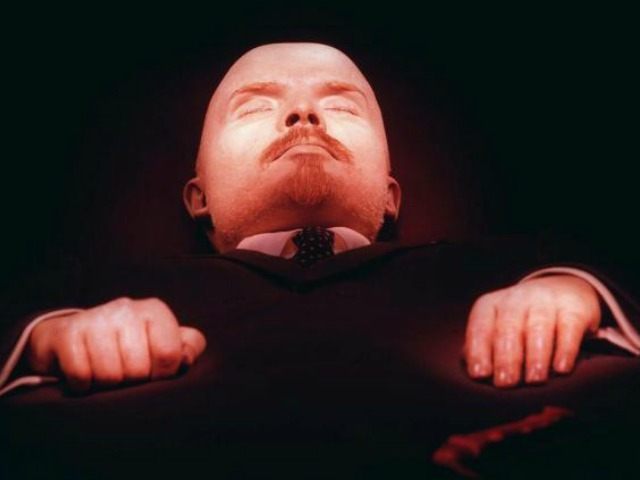Vladimir Lenin, the man who founded the USSR and forced Russia into a Communist state, died 90 years ago. However, the dictator looks better in death due to experimental embalming techniques by Russian scientists.
The scientists reached near perfection on April 22, which was Lenin’s 145th birthday.
Scientific American reported that the scientists at the Center for Scientific Research and Teaching Methods in Biochemical Technologies in Moscow have been working on Lenin’s body since he died. The institute assigned “five to six anatomists, biochemists and surgeons” to Lenin, along with Vietnamese leader Ho Chi Minh and North Korean dictators Kim Il-sung and Kim Jong-il. During their experiments, the scientists “created a ‘quasibiological’ science that differs from other embalming methods.”
“They have to substitute occasional parts of skin and flesh with plastics and other materials, so in terms of the original biological matter the body is less and less of what it used to be,” explained Professor Alexei Yurchak in social anthropology at the University of California. “That makes it dramatically different from everything in the past, such as mummification, where the focus was on preserving the original matter while the form of the body changes.”
Yurchak published a paper in Representations on the process.
“The extraordinary results of this project have never been known to the public; in fact, they have been actively hidden from public view,” he wrote. “Visitors to the mausoleum see Lenin lying in a glass sarcophagus dressed in a dark suit; only his head and hands are uncovered and visible (figs. 2, 3). They never learn that the body’s joints remain flexible, the internal pressure of its skin is maintained, and its invisible surfaces are painstakingly and continually re-sculpted. No one has ever been able to appreciate these extraordinary achievements. No one, that is, with the exception of a small group of scientists and state leaders.”
As Yurchak points out, it is very important to understand why a government would invest time and energy to preserve a human body. Lenin died on January 21, 1924. The leaders did not want to perform a long-term preservation process on Lenin, but just long enough to allow people to view his body. He passed away in the middle of winter, which allowed his body to remain in good condition for two months. The USSR displayed his body for four days while millions of people travelled from across the massive country to say good-bye. Here is footage from his funeral:
During this time, the leaders thought about their decision and told the nation “that Soviet science and researchers were responsible for preserving and maintaining it.” The first experiment only lasted a few months, since the doctor severed Lenin’s “major arteries and other blood vessels” during the autopsy, which meant the embalming fluids could not flow through the body. This led them to develop new ways to embalm Lenin:
Lenin Lab researchers eventually developed microinjection techniques that used single needles to deliver embalming fluids to certain bodily parts, preferentially places where cuts or scars from past treatments already existed, Yurchak says. They also created a double-layered rubber suit to keep a thin layer of embalming fluid covering Lenin’s body during public display; a regular suit of clothes fits over the rubber suit. The body gets reembalmed once every other year; a process that involves submerging the body in separate solutions of glycerol solution baths, formaldehyde, potassium acetate, alcohol, hydrogen peroxide, acetic acid solution and acetic sodium. Each session takes about one and a half months.
The lab eventually placed fake eyelashes on the dictator. Mold and wrinkles also complicated things for the scientists. They even formed “artificial skin patches when a piece of skin on Lenin’s foot went missing in 1945.” The majority of his skin is now “moldable material made of paraffin, glycerin and carotene has replaced much of the skin fat to maintain the original ‘landscape’ of the skin.”
Josef Stalin, Lenin’s successor and a man who murder over 20 million of his own people, was also embalmed after he died on October 16, 1952. Yet, the government removed his body from Lenin’s tomb in 1961 after his successor Nikita Krushchev blasted the cult of personality that surrounded Stalin. The country could not “justify maintaining the body of a man who began life as a son of a Georgian shoemaker but became a despot.” Therefore, the USSR buried his body, but continued to preserve Lenin. Funds, though, dried up after the USSR collapsed in 1991, but private donations allow the Lenin Lab to continue their work.

COMMENTS
Please let us know if you're having issues with commenting.